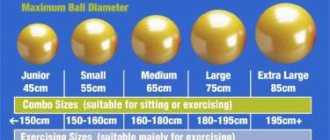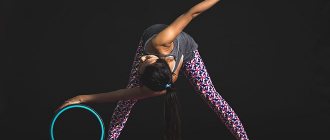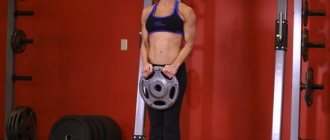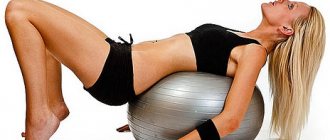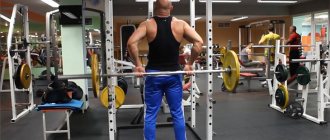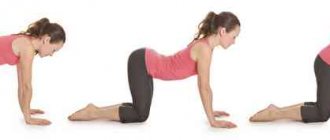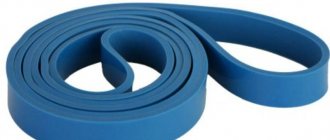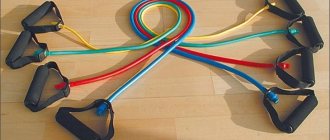What is fitball?
A fitball or gymnastic ball is a unique exercise machine. The rounded shape and wide coverage allow you to perform gymnastic approaches with greater amplitude, and thanks to the instability of this fitness ball, the muscles are kept in tension throughout the entire workout.
From my own practice, I can say that a set of exercises involving a fit ball has a beneficial effect on the spine, helps strengthen the hips, and especially the back and abs. In addition to balanced tone, regular training on the ball helps get rid of pinched intervertebral discs. Such exercises can eliminate pain in the neck/collar area, improve blood circulation, speed up metabolism and fat burning processes.
The condition of the vestibular apparatus, posture is noticeably improved and the muscle corset is strengthened. Your body gains flexibility and lightness, and you gain a cheerful mood.
Exercises for back muscles on a fitball:
Surely, many of you have noticed that exercises on completely different muscle groups have a multifunctional effect. For example, by working your arms, you will successfully pump up your back muscles. Therefore, in this section I do not give many exercises for this beautiful part of our body. But the exercises that are included in this chapter will help you strengthen your spine, lower back, have strong back muscles and forget about pain in these parts of the body, which are especially tired with a sedentary lifestyle.
Exercise 1:
The exercise effectively strengthens the spinal extensor muscles, which will reduce the risk of back injury when bending or turning the body.
Starting position: take dumbbells and lie on your stomach on the fitball, resting on your bent knees. The arms are freely lowered down, the elbows are bent, the palms are directed inward. Twist your tailbone forward so that your lower abdomen is pressed against the exercise ball. Don't lower your head, look at the floor.
From this position, raise your head and shoulders. Slowly raise your arms to the sides at shoulder level. At the same time, do not allow the lower back to bend.
Then raise your left arm and left shoulder even higher, twisting your spine to the right. The right hand is motionless.
Hold this position for five counts and slowly return to the starting position. Perform four repetitions on one side. Then rest for one minute. Do the exercise again, but in the other direction.
Gradually increase the number of turns to 8-10. As muscle strength develops, take heavier dumbbells, but the number of repetitions should not exceed four times. At the initial stage, the weight of dumbbells should be 1.5–2 kilograms.
Exercise 2:
The exercise strengthens the abdominal muscles, engages the muscles of the buttocks, legs, shoulders, and upper back. The back extensors work as stabilizers.
Starting position: Sit on the exercise ball, then move your feet forward until your head, shoulders and upper back are on the exercise ball, with your knees bent and directly above your ankles.
From this position, tighten your abs to achieve a neutral spine position. The body should be parallel to the floor. Then extend your arms out to the sides, palms down.
Attention: arms must be straight throughout the entire exercise.
Rotate your body to the left while straightening your legs and touching the floor with the fingers of your left hand for stability. Return to the starting position and repeat the exercise, turning your body to the right. This will be one repetition.
When starting out, start with 1-2 sets of 12-16 reps each (alternating sides). As muscle strength develops, increase the number of sets to 3, and leave the number of repetitions unchanged - 16 times.
Be sure to rest 30 seconds to 1 minute between sets.
Exercise 3:
The exercise effectively strengthens the spinal extensors and abdominal muscles.
Starting position: lie on your stomach on a fitball, placing your palms on the floor shoulder-width apart. Stepping with your hands, move your body a little forward so that the fitball is under your knees and your body forms a straight line. Legs straight, feet together, hands directly under the shoulder joints. To maintain balance, tighten your core muscles, but keep your head and neck relaxed.
From this position, tighten your abs and, without bending your legs, lift your hips up so that you rest your feet on the exercise ball. Slowly return to the starting position.
At the initial stage, start with 1-2 sets of 8-10 repetitions each. Then, if desired, you can increase the number of repetitions up to 12 times, and the number of sets – up to 3.
Attention: When rolling the ball with your feet, pull your hips closer to your chest and do not put weight on your arms.
Be sure to rest 30 seconds to 1 minute between sets.
Exercise 4:
The exercise effectively strengthens the spinal extensors, upper back muscles, posterior deltoid muscles, as well as the abdominal and buttock muscles.
Starting position: lie on the exercise ball with your chest, stomach and hips, with your feet resting on your back. Place your arms in front of your chest, keeping your elbows loose.
From this position, tighten your abs and pull your tailbone forward to fix the position of the body. Then straighten your back and legs, lifting your arms and chest off the fitball. Extend your arms to the sides and lower your shoulder blades. Turn your palms forward, thumbs pointing up. With a slow movement, turn your hands with your thumbs down, lower your body onto the fitball and fold your arms in front of your chest, do not bend your legs. Initially, start with 1 set of 10 repetitions. As muscle strength develops, increase the number of sets to 2–3 and the number of repetitions to 12–15.
Be sure to rest 30 seconds to 1 minute between sets.
Exercise 5:
This exercise effectively strengthens the lumbar spine.
Starting position: lie on the fitball with your stomach, legs straight, toes pointing to the floor, arms crossed at the back of your head, body lowered down. From this position, slowly raise your body in line with your legs straight. Then also slowly return to the starting position.
If you are a beginner, limit your range of motion to being in line with your legs. Then it will be possible to lift the body with full amplitude, but not above the line of the legs. When you feel that the exercise is too easy, pick up a weight.
Initially, start with 2 sets of 8 repetitions each. As your lower back strengthens, increase the number of sets to 3 and the number of repetitions to 12. Then increase the number of repetitions to 15, to 20.
Be sure to rest 30 seconds to 1 minute between sets.
Exercise 6:
This exercise effectively strengthens the lumbar spine.
Starting position: lie on the fitball with your stomach, legs straight, feet connected together and freely lowered down, arms at a distance slightly wider than shoulders, hands resting on the floor in front of you, hands located strictly under the shoulder joints, do not throw your head back, look at the floor.
From this position, slowly lift your right leg and left arm up at the same time. Return to the starting position and perform the exercise with the other arm and leg.
At the initial stage, start with 1-2 sets of 8-10 repetitions.
When you master this movement, move on to a more complex version, or pick up a dumbbell (2-3 kg).
Execution option for advanced:
Lying on a fitball, lift both legs up at the same time.
Return to the starting position.
At an advanced level, perform the exercise in 3-4 sets of 12-15 repetitions each.
Be sure to rest 30 seconds to 1 minute between sets.
I advise you to perform exercises 5 and 6 on the lower back simultaneously with abdominal exercises (twisting on a fitball - exercise 1).
Option for beginners:
Based on the book by Lucy Burbo “I have a SEXY figure. Effective fitness and body care."
Share the article with your friends on social networks!
More on the same topic:
Comments (0)
Types of fitball
Personally, I have dealt with a variety of different types of these sports equipment. They differ in diameter and elasticity. Each such fit ball can withstand up to 300 kilograms of load weight (at least in practice, I have never seen people exercising with a higher weight). Their diameter can be 45-85 centimeters. First of all, I recommend choosing the size depending on the height of the trainee. Here it would be appropriate to talk about the ratio of your height to the diameter of the ball.
Let me give a typical example of such relationships:
- up to 152 cm – 45 cm
- 152-165 – 55 cm
- 165-185 – 65 cm
- 185-200 – 75 cm
- 200 or more – 85 cm
How to choose the right fitball: some practical tips
There are several parameters that you need to pay attention to when choosing a gymnastic ball:
- Seams. They should not be obvious, otherwise during training they may rub the skin and, accordingly, reduce the effect of the training.
- Material. To avoid allergic reactions, the product must contain antistatic agents.
- Size. As a rule, balls come in 55 cm, 65 cm and 75 cm. You need to select the size based on the height of the player. The first are suitable for heights of 149-164 cm, the second – 164-171 cm, the third – above 180 centimeters.
Tip #3! When choosing a ball, sit on top of it. Hips and knees should form a right angle with the floor surface.
- Anti-break function. When purchasing, pay attention to the abbreviations: ABS, BRQ and “anti-rupture system.” This indicates that the ball will not suddenly break.
- Weight. Pay attention to the maximum possible weight that the gymnastic ball can support. This is relevant for overweight people and athletes who want to exercise on a fitball with heavy weights.
- Pump. The presence of a pump in the kit greatly simplifies the procedure for using the ball. Otherwise, you will have to start looking for him, because... You need to inflate the ball yourself. When inflating, make sure that the air is distributed evenly.
How to choose the right fitball?
As I already said, the main selection criterion is the height/diameter ratio. To correctly determine this ratio, if you have never seen such a fitness ball, I advise you to sit on the ball and make sure that your hips are at the same level as your knees or slightly higher.
If you decide to purchase a personal projectile, I do not advise you to buy it at markets and other “sharashkin’s offices”. I recommend choosing high-quality balls from those sold in sports stores. Basically, they supply models manufactured in accordance with GOST and relevant standards.
Remember that the correct choice of a fit ball greatly affects the quality of your exercises and the final result. Color and texture are important, of course, but comfort should always be at the forefront.
Try the fit ball to the touch - it should not be sticky and cold, it should not form wrinkles after pinching, and when pressed it should not cushion too much (but not so much that your hand sinks into it).
The main thing to understand is that in order not to harm yourself and to exercise comfortably and with pleasure, you should approach your choice responsibly.
The benefits and harms of fitball for the back
If you have a whole range of fitness exercises on your agenda, I strongly advise you to include a fit ball in it. It will help not only diversify gymnastics, but also saturate the program with effective means of strengthening or stretching muscles and ligaments.
I can say that such training is especially effective if you want to strengthen your hips and abs. During the classes, deep muscle groups are worked out, which we rarely include in work by more than 40-50% during normal aerobic exercise. Regular exercise will improve your posture and eliminate pain in the lumbar region.
In general, if you carry out the approaches correctly, do not overload the body, work at the right pace accompanied by an instructor (which is highly desirable), and follow cycles of tension and relaxation, excluding overload and overtraining, such sports activity will not cause harm.
Set of exercises
Strengthening the lower back, cervical and thoracic back is recommended for people who often experience pain in a particular area, including chronic pain. This is especially true for patients with a hernia of the spinal column or osteochondrosis.
In combination with gymnastics for the lumbar region, experts recommend doing abdominal gymnastics. The fitball helps strengthen the lateral abdominals, which creates a good muscular corset for the entire body.
Hyperextension
Reverse hyperextension on a fitball
For patients with intervertebral hernia, ordinary hyperextension can be dangerous, but exercise with a fitball is completely safe. The reduction in the load on the damaged area is due to greater depreciation during the exercise than with the usual version without a projectile.
The person needs to lie on the ball with their stomach down. The fulcrum is on the thigh area and lower abdomen. There is no need to be afraid to lie down on a fitball. Such sports equipment is dense enough to support a person’s weight without bursting. You don't need to pump it up much to do this.
After taking the starting position, you need to make sure that your toes rest on the floor and your legs are straight next to each other. Hands are placed behind the head, the head is set straight, the gaze is forward. The lower back is bent until the pelvis is pointed upward. This position must be maintained throughout the entire period of gymnastics.
Next, the body is tilted down as far as possible. In any case, the lower back should not be rounded. Do 10-15 bends, excluding sudden movements and jerks. Even if a person has poor stretching, this does not prevent the exercise from being performed effectively.
boat
Boat option with fitball
The exercise is similar to the usual version, when a person lies on the floor. However, in this case it is placed on a gymnastic ball. The disadvantage is that once you get into a position while lying on a stability ball, you need to maintain your balance after your legs move away from the support.
It is not recommended to perform the “boat” for elderly people, as well as for those undergoing rehabilitation treatment after spinal injury (after a vertebral fracture or surgery to eliminate body displacement).
Leg Raise
More complex exercises are not recommended until balance has been mastered.
Starting position - lying on your stomach on a gymnastic ball, with your hands resting on the floor. Next, alternately raise the left and right legs until tension is felt in the lumbar region. You need to hold at the maximum point for 3-5 seconds. You need to do 10-15 lifts with each leg.
Afterwards, you can change position, turning over from your stomach to your back and repeat the exercise. In this case, the abdominal muscles are strengthened.
Massage of the spine and back muscles
The treatment is especially useful for people who have a hernia in the spine. The massage is performed like this:
- sit on an exercise ball with your feet shoulder-width apart;
- go down with your back on the fitball, put your hands behind your head;
- bend over so that your back rests firmly on the ball;
- roll back and forth, sideways 10 times in each position.
After performing the exercise, you need to lie on the ball to relax your back for 5-10 minutes.
Indications and contraindications for fitball exercises
For hernia
Among the indications for fitball classes for children and adults, I can note intervertebral hernias in various sections, including the collar area, thoracic and lumbar sections. A properly selected program helps relieve pinching, spasm of muscle fibers along the spine and bring them into a healthy tone. I strongly do not recommend such activity at the stage of exacerbation of inflammatory processes.
For scoliosis and curvatures
A special fitball complex is very effective, especially if you have a history of acquired and congenital scoliosis, or a certain stage of spinal curvature. With a competent approach, the vertebrae come to the desired position and are fixed in it at the muscular-ligamentous level. In fact, this is one way to avoid wearing corsets and a good addition to manual therapy.
Speaking about general contraindications, I note that such loads can be dangerous for women in the first trimester of pregnancy and with its problematic course. This activity is also contraindicated in case of isthmic-cervical insufficiency and increased uterine tone. Therefore, before you include it in your complex without the supervision of a fitness trainer, you must consult a doctor.
Tips and cautions before starting classes
Before performing a set of fitball exercises for your back, be sure to read the recommendations that I will give below:
- If you are dealing with a fit ball for the first time, you should not try to master the entire complex at once. It is advisable to familiarize yourself with the apparatus, sit comfortably on it and jump. This way you will understand how to maintain balance correctly.
- For maximum comfort and benefit, it is important to choose a ball that suits your height.
- Do not hold your breath under any circumstances - it should be measured and free.
- If you have problems with the spine, you should first consult with a physical therapy instructor - he will tell you which fitball exercises will be useful, how to do them correctly, and select the appropriate pace.
- Conduct classes no earlier than 2 hours after eating.
Warm-up and cool-down
Warm-up and cool-down
- Be sure to warm up and exercise before each fitball workout. You can practice intense running in place or on a treadmill. This way you can warm up your muscles well and prepare them for a full workout, as well as eliminate sprains and cramps.
- Cooling down or relaxing is a mandatory part that should end a fitball workout:
- We place our straightened legs with our calves on the ball.
- We lie down for 10 minutes, breathe freely and relax.
By performing these techniques correctly, you relieve painful spasms of the lower back and unload the muscular spinal corset.
Safety
From my own practice I have learned several important warnings. Firstly, never train earlier than 2 hours after eating and without first warming up! Watch your breathing and don't lose your rhythm. Learn to relax well after each approach. These are three pillars of safe and effective aerobic exercise. Now let’s look at a version of classic fitball training.
A set of exercises for the back and spine
Bridge
This fitball exercise resembles a classic bridge, but unlike it, it is more useful and less traumatic:
- From a supine position, place your calves on the ball, with your hands pressed to the floor.
- Lifting your pelvis off the floor, roll the ball, placing the ball in the middle part of your back, forming a bridge.
- We stay in this pose for 5-10 seconds.
At first, 3 repetitions are enough. You can gradually add one at a time.
Plank
Almost all parts of the body are involved here, including the latissimus dorsi muscles:
- Lying on the ball with your stomach, we begin to gradually roll forward, accompanying the process by finely moving our hands. The feet are placed on the apparatus, and the hands are on the floor, bent at the elbows.
- Leaning on your elbows and palms, we fix your feet in a stable position on the fitness ball.
- We tense the body, draw in the stomach without bending the lower back. Let's look down.
boat
During the execution, a muscle corset is formed, waist size is reduced, and the latissimus muscles are worked out:
- We lie on our stomach on a fitness ball, bring our legs together and stretch our arms forward.
- We slowly bend as we exhale, trying to raise our straightened arms and legs upward.
- Let's hold this position for a few seconds, then lower our legs and arms and relax.
I recommend doing 3 sets with a minute rest between each.
Superman
In this case, we work on the spinal area, abdominal groups, buttock shoulders and back of the thigh:
- Having placed your stomach on the apparatus, we stretch our legs back. We straighten our arms in front of us. Place your palms on the floor, taking the starting position.
- Straighten up and raise your arms to the same level as your body. We pause and return to the starting position.
Hyperextension
These fitball exercises allow you to alternate between relaxation and tension in the lower back, relieving spasm. Additional stabilizing muscle groups are included in the work:
- We lie on the fitness ball with our stomach so that the body fits loosely around the apparatus. We move our hands behind our heads or place them in front of us.
- Raise your body until your legs are in a straight line with your back. Strong deflections should be avoided.
- We hold this position for several seconds and slowly return to the starting position.
I recommend doing 3 sets of 10 repetitions.
Crunches
In this case, we work the abs and stretch the back muscles, effectively burning fat deposits on the sides and lower back:
- Lying on a fit ball, bend your knees at a right angle, rest them on the floor, and place your hands behind your head.
- We lift and lower the upper body, as in a regular ab pump on the floor.
Do 3-15 approaches with a gradual increase in their number from minimum to maximum.
Leg Raise
The main focus is on working the buttocks and hamstrings:
- We lie on the mat and hold the ball with our shins and ankles. We rest ourselves with our hands or put them behind our heads. Strain your lower back and pull in your stomach.
- We squeeze the ball with our feet and lift it to a vertical position. Smoothly lower as you exhale until it makes contact with the floor.
TOP 8 exercises with fitball for weight loss
Let's look at the simplest and most popular movements:
Crunches with a fitball
Lie on your back, bend your knees, place your feet on the floor. Place the fitball on your hips and press it with straight arms. Perform a twist by pushing the ball upward. Return to the starting position.
Leg bending on a fitball
Lie on your back, rest your feet on the fitball. Raise your pelvis as high as possible and straighten your legs at the knee joints. Then bend it back. When performing the exercise, constantly try to push your pelvis as high as possible.
Extended glute bridge on a fitball
Lie on your back. Place your heels on the exercise ball so that your legs are straight. Push your pelvis as high as possible, tightening your buttocks, and return back.
Palm plank with fitball
Take a lying position with your palms on the fitball. “Twist” your pelvis, tighten your abdominal muscles as much as possible and stay in this position for a certain time. Keep your arms straight.
Side lunge with fitball
From a standing position, move your leg to the side and place your foot on the exercise ball so that your leg is straight. Perform a squat on the supporting leg and return back.
Hyperextension on a fitball
Lie on your stomach on a fitball, cross your arms. Get down as low as possible, rounding your back, and rise up. During the exercise, tense your buttocks as much as possible.
Stepping with hands while lying on a fitball
Lie with your hips on the fitball and take a lying position. “Twist” your pelvis, tighten your abdominal muscles. Without losing this position, take a few steps forward with your hands. Then return to the starting position.
Climber with one leg using a fitball
Place the shin of one leg on the fitball and take a prone position. Keep your other leg suspended. “Twist” your pelvis, tighten your abdominal muscles. Pull your knee towards your chest and return to the starting position. Do the required number of repetitions on one leg, then switch.
Reviews about using a fitball for the back
Elena, St. Petersburg, 25 years old:
I started working out with a fit ball on the recommendation of a physical therapy doctor. I have a protrusion of the cervical spine. I added training to Dikul’s exercises. A month later I felt good relief in the cervical spine and lightness. My head became clearer, and it became easier to sit through everyday office life. A very effective thing, I recommend it!
Maxim, N. Novgorod, 32 years old:
I went to an orthopedist for a herniated disc in the lumbar region, went for massages, and even visited the Bubnovsky center. It seems like he is on the mend, but somehow very slowly. On the advice of a therapist, I went for a consultation with a fitball instructor. I became interested in the program, made a schedule and started studying. At first it was hard, but after two weeks I felt how my lower back was unloaded, walking, sitting and especially lying down became much easier. I will continue in the same spirit)
